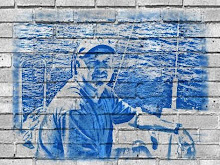 Drypoint etching is an intaglio technique used in preparing metal plates for printmaking by means of which lines are scratched directly into the plate. Thicker lines are made by applying more pressure to the burin (graver) or etching needle (also a roulette, chalk roll and matting wheel). Thus incising the cold metal creates ragged ridges, called the burr, thrown up along to edge the furrows cut into it. The burr is removed in copperplate engraving but not in drypoint, where it is kept to produce soft, blurred line and painterly effects.
Drypoint etching is an intaglio technique used in preparing metal plates for printmaking by means of which lines are scratched directly into the plate. Thicker lines are made by applying more pressure to the burin (graver) or etching needle (also a roulette, chalk roll and matting wheel). Thus incising the cold metal creates ragged ridges, called the burr, thrown up along to edge the furrows cut into it. The burr is removed in copperplate engraving but not in drypoint, where it is kept to produce soft, blurred line and painterly effects. The etching on the left was done by Emil Nolde in 1907 and prints sell for $3,000 to $4,000. The prints I did (below) could be obtained for considerably less!!


1 comment:
Hi John--
I've fallen in like. This is Outstanding!!! I really liked the the image before the elephant came into focus. And that elephant is like icing on the cake!
Always wanted to do printmaking but could never rationalize making copies. Settled on Pen and Ink drawing. What do you do with all the copies? Sell them? Where? This is a terrific image, John.
\\///\
PS--I always wondered what the difference between drypoint and engraving was. Thanks.
Post a Comment